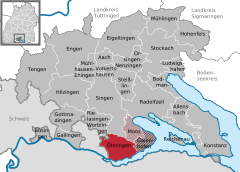Öhningen
| Öhningen | ||
|---|---|---|
| ||
 Öhningen | ||
Location of Öhningen within Konstanz district 
 | ||
| Coordinates: 47°39′41″N 8°53′19″E / 47.66139°N 8.88861°ECoordinates: 47°39′41″N 8°53′19″E / 47.66139°N 8.88861°E | ||
| Country | Germany | |
| State | Baden-Württemberg | |
| Admin. region | Freiburg | |
| District | Konstanz | |
| Government | ||
| • Mayor | Andreas Schmid | |
| Area | ||
| • Total | 28.20 km2 (10.89 sq mi) | |
| Elevation | 499 m (1,637 ft) | |
| Population (2012-12-31)[1] | ||
| • Total | 3,530 | |
| • Density | 130/km2 (320/sq mi) | |
| Time zone | CET/CEST (UTC+1/+2) | |
| Postal codes | 78337 | |
| Dialling codes | 07735 | |
| Vehicle registration | KN | |
| Website | www.oehningen.de | |
Öhningen is a town on the western edge of Lake Constance where it forms the border between Switzerland and the district of Konstanz (or Constance) in Baden-Württemberg in Germany.
World heritage site
It is home to one or more prehistoric pile-dwelling (or stilt house) settlements that are part of the Prehistoric Pile dwellings around the Alps UNESCO World Heritage Site.[2]
Palaeontology
The discovery of the fossil Andrias scheuchzeri in 1726 by the Zurich city physician Johann Jakob Scheuchzer in Öhningen (Dutch: Oeningen) placed this town firmly in the history annals of palaeontology because Scheuchzer interpreted his find as the skeletal remains of a child who suffered the biblical deluge, and which he referred to as Homo diluvii. Later in the 1770's it was determined to be a fossilized lizard and it was finally identified as the giant salamander in 1811 by George Cuvier after he hacked gently away at the specimen to reveal the limbs. The site at Öhningen has also yeilded a rich material of other fossils including many insects.
References
- ↑ [Statistisches Bundesamt – Gemeinden in Deutschland mit Bevölkerung am 31.12.2012 (XLS-Datei; 4,0 MB) (Einwohnerzahlen auf Grundlage des Zensus 2011) "Gemeinden in Deutschland mit Bevölkerung am 31.12.2012"]. Statistisches Bundesamt (in German). 12 November 2013.
- ↑ UNESCO World Heritage Site - Prehistoric Pile dwellings around the Alps
| |||||||
